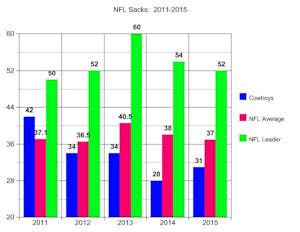In our efforts to solve the Cowboys' pass rush issues, I always think that sometimes we are looking in the wrong place for the proper measuring stick. There are so many variables that go into evaluation for this type of thing; especially when your efforts need to be measured against 31 teams. NFL average is a worthy pursuit, especially if you haven't been at or above the NFL average since 2011. That is now five seasons back and the Cowboys have spent the last four in the bottom of the league as it pertains to raw sack numbers.
The problem, of course, is that all things are never equal in the NFL. Team X gets 60 sacks and Team Y gets 30. However, upon closer inspection, we find out Team Y gets no sacks because teams are running the ball so much against them. Maybe their offense is incompetent, and the opponent is always ahead in the second half. Why would they pass and subject their QB to danger when a simple run down the throat is all it takes to ensure victory?
If some teams are facing 50 passes a game and some teams are facing 25, then it stands to reason that we'd better not look at raw sack totals to evaluate the pass rush.
Just for fun, here is what the raw sack totals look like, though, as we separate them into three categories: In Green, we put the best team in the NFL. For your reference, the leaders in the last five years have been - Philadelphia in 2011, Denver in 2012, Carolina in 2013, Buffalo in 2014, and Denver in 2015. In red, we put the NFL average. This is how many total sacks the average team gets each year. And then, in blue, is your Dallas Cowboys in a five-year trend:

The Cowboys' league ranking in sacks since 2011: 9th, 22nd, 28th, 29th, and 26th. So, since 2012, they have been bouncing around the basement. 2011-12 was Rob Ryan and a healthy DeMarcus Ware and a helping of Jay Ratliff. 2013 was the Monte Kiffin year, and 2014-15 have been our current defensive architect, Rod Marinelli. Not to lower our bar or anything, but you can see how most of us just want to see the Cowboys climb into the 50th percentile in the league to feel like the pass rush has made major strides. Being in the top 5 will require a massive investment and talent change, and although the Cowboys flirt with putting resources into this spot, they obviously do not have elite pass rushers right now. So, to put this on tactics and strategies is simply unfair.
That said, let's now visit about the stat that coaches really focus upon. This is what makes all things equal from a statistical point of view. It is sack rate. In other words, how many pass plays does it take to get a sack? If the average NFL game features each team attempting 38 pass plays (2015 numbers), then the question is based on expectation levels of how many pass plays does it require each defense to get a sack?
Now, see the data from above applied in that way: How many passes do the Cowboys need for each sack? In case there is any confusion, you want your bar to be small on this chart.

And here we see the progress of 2015. Since moving from the 3-4 to the 4-3, the Cowboys have been taking between 19 and 21 pass plays to get to the QB. They needed way more pass plays than the league average to get there. They just couldn't do it in 2013 and 2014. Heck, in 2014, you can see Buffalo was almost completely doubling up the Cowboys. It took the Bills just 11 passes to record a sack, but the Cowboys needed 21. But, in 2015, the Cowboys cut that number down by a huge chunk. Almost to a point where in 2015, the Cowboys column and the NFL average column almost were at the same height. This is pretty major progress, to be honest. It is basically a 20 percent improvement.
Of course, it required a season of Greg Hardy and DeMarcus Lawrence and quite a few pieces that aren't here in 2016. But, we need to understand sack totals from a proper perspective. If your team is always ahead, you are going to get more sacks because your opponent has to throw (theoretically, that should have been 2014 for Dallas). If your team is always behind, you are going to have a real issue getting to the QB because your opponent doesn't ever have to throw.
And since we know how dramatically different the game situations were in 2014 and 2015, we are led to conclude that the 2014 pass rush was simply awful (despite the rest of the team being pretty nice) and the 2015 pass rush was not far at all from being a league-average pass rush.
That said, since Hardy was so difficult the team just wanted him gone and since Lawrence and Gregory both got popped with suspensions, it is hard to say that there is any relation to the 2015 pass rush and the mysterious 2016 rush group. There is also the consideration of how often do you blitz to get your sacks, but I wanted to keep this study simple. If you blitz, you leave more space in your secondary, so it is all a balancing act.
Quite possibly, irrelevant, but just for your info: In the preseason opener, the Rams attempted 42 pass plays and were sacked once. That clearly won't cut it.
The league average has sat at right about one sack per 16 pass plays for the last five years. That needs to be the goal that the coaching staff is setting for the team. Whether they can get close is a whole other story.

No comments:
Post a Comment